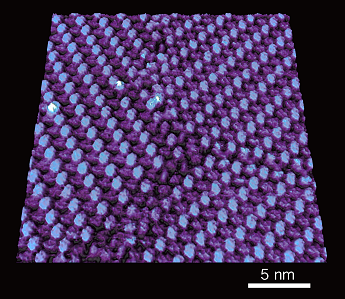
Caption:
The image shows molecules of perylenetetracarboxylic dianhydride self-assembling on the surface of a silver crystal, forming well-ordered herringbone-like patterns with periodic height variations. Three molecular domains touch each other and form three grain boundaries.
Xiaolong Liu
Advisor: Mark Hersam
Applied Physics Program
Northwestern University, Evanston, IL 60208
Laboratory website: http://www.hersam-group.northwestern.edu/
Technique: Scanning Tunneling Microscopy
Description:
My current research focuses on exploring functionalized two dimensional (2D) nanomaterials at the molecular and atomic scales using scanning tunneling microscopy and spectroscopy (STM/STS). Junctions formed by self-assembled organic monolayers and 2D nanomaterials (e.g., graphene) are promising candidates for next generation electronics, especially for flexible devices. The examination of fundamental properties such as grain boundaries, defects and molecule conformations via STM/STS would greatly facilitate rational choice of molecules, as well as revealing interface properties that are essential before such junctions can be employed in real world applications. This image gives an example of a monolayer of self-assembled perylenetetracarboxylic dianhydride molecules, highlighting the three grain boundaries formed from three merging grains. In addition to the herringbone structures of the self-assembled molecules, periodic height modulations are observed for every other row. The grain boundaries might play an important role in affecting the electronic and seeding properties when used in electronics.
Funding Source: U.S. Department of Energy SISGR program (DOE DE-FG02-09ER16109)


